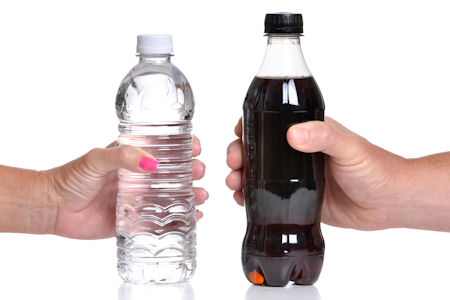 Ah, soda — that sweet, fizzy pick-me-up.
Ah, soda — that sweet, fizzy pick-me-up.
The dangers of soda, of course, are well understood. Most soda these days contain a sweetener called fructose, usually in the form of high-fructose corn syrup (check the label) rather than sucrose, which is the formal name for good old table sugar. Fructose is more inexpensive than sucrose and achieves a similar level of sweetness, so manufacturers for years have been choosing fructose over sucrose in their products.
However, fructose behaves differently in the body than sucrose. For instance, fructose is metabolized, or processed, mostly in the liver where it’s transformed into fatty acids. Some of those fatty acids stay in the liver, leaving it marbled like a nice cut of beef and contributing to fatty liver disease — a condition often encountered by alcoholics. When those fatty acids that aren’t wreaking havoc on the liver reach the blood stream, they cause severe swings in blood sugar levels and escalate the body’s resistance to insulin, which can lead to type 2 diabetes. They also contribute to obesity, higher levels of triglycerides and “bad” cholesterol and more in ways sucrose doesn’t.
We know all of this because of research. Studies have been conducted on subjects — animal and human alike — to study how fructose behaves in the body.
What had not been previously studied, however, was how fructose behaved in relation to physical activity.
A researcher at Syracuse University decided to rectify this. She got together more than 20 healthy, college-age men and women who would agree to drink soda as part of a scientific research project. That was the easy part.
After some baseline tests in the university’s physiology lab, participants were told to consume about 75 grams of a fructose-containing soda each day — which is on par with how much soda the average American consumes daily. This added about 500 calories to the participants’ diets, so they were encouraged to cut calories elsewhere; the research was to see how fructose behaved in the body, not how pudgy they could make college kids.
The participants were given an activity tracker, like the popular Fitbit device, and half were told to move as much as they ordinarily did. The other half was encouraged to get up and move a bit more, with the goal of achieving about 12,000 steps each day, or a distance of about six miles.
After two weeks, the participants came back to the lab, had more tests done, and then switched — the active ones were told to back off, the others were told to go for 12,000 steps a day.
The research, published recently in Medicine & Science in Sports & Exercise and in The European Journal of Clinical Nutrition, found that those who walked at least 12,000 steps a day were able to largely undo the damage fructose did to their metabolic system and bodies. Cholesterol and blood sugar levels remained normal, even though they consumed fructose each day during the study.
The research does not signal a big “all clear” on the issue of drinking fructose; but it does show that activity can cause the body to process things differently.
Oh, and how did those participants get to 12,000 steps a day? Most didn’t alter their established exercise routines. Rather, they just got up and moved around more often. They reported parking farther away from the store, taking the stairs rather than the elevator and more. It was the small things that helped make the biggest difference.
So, the lesson is, first, make soda an occasional treat and use water as a stable of your diet. And, even casual movement can pay big dividends in how your body works.